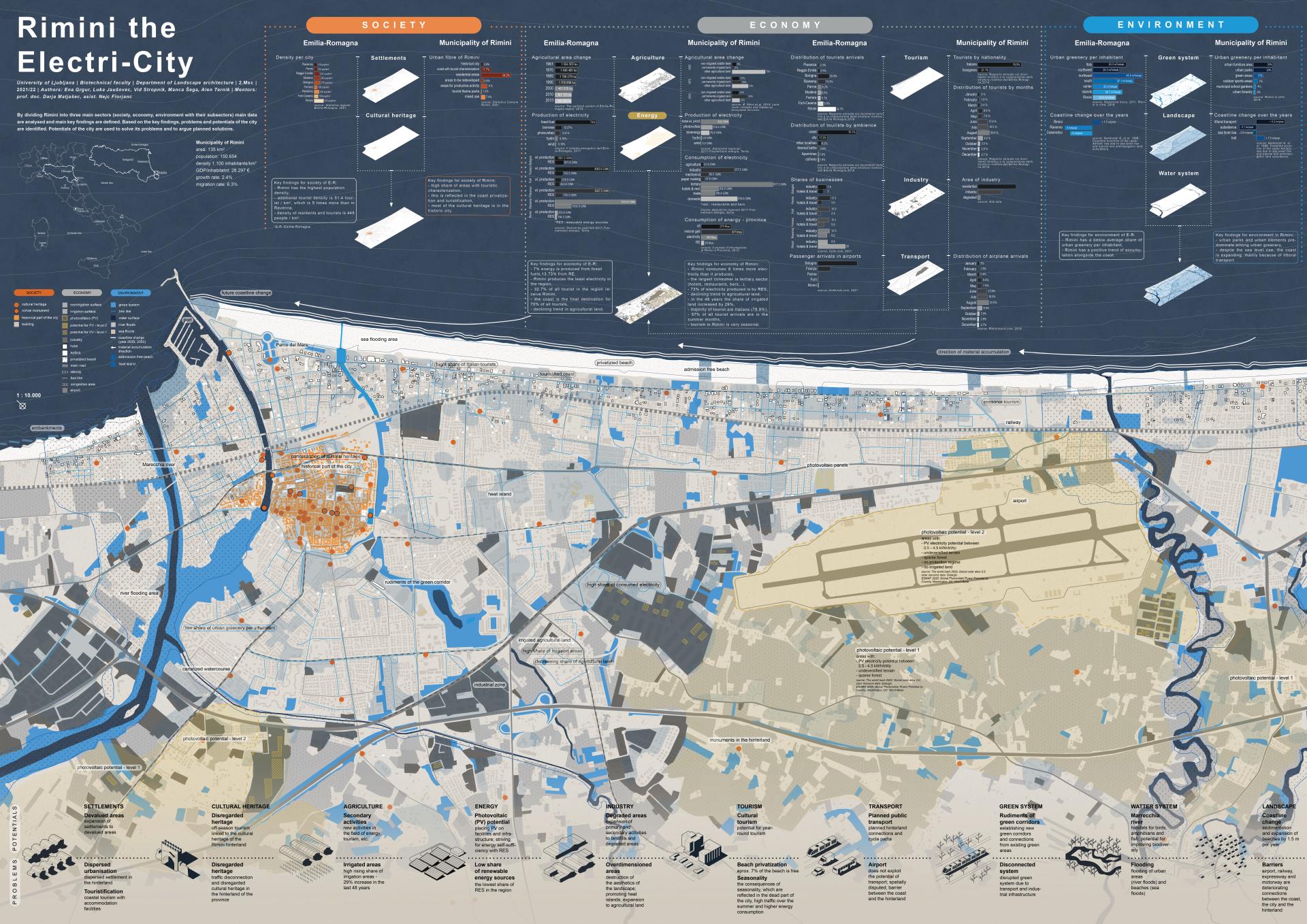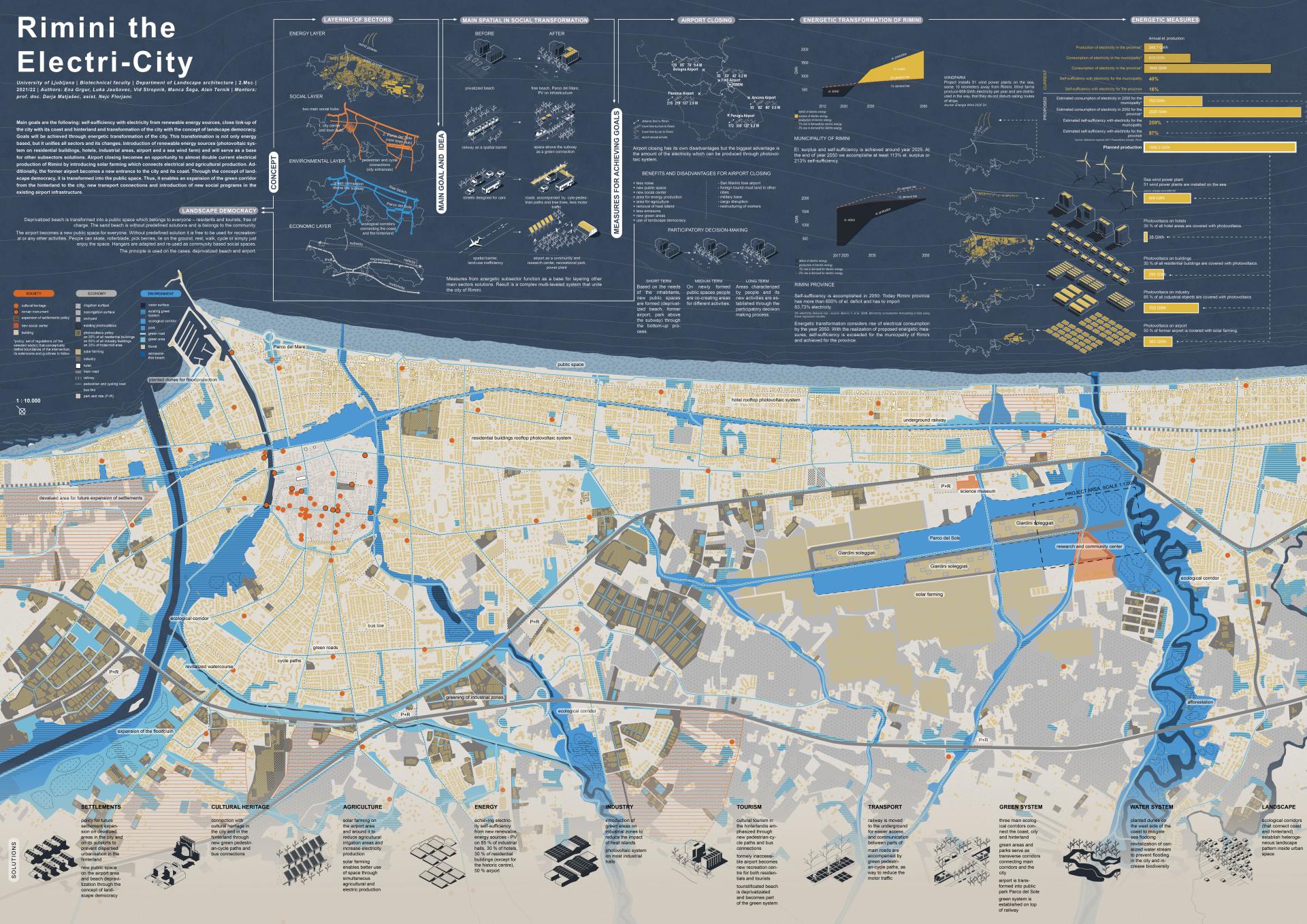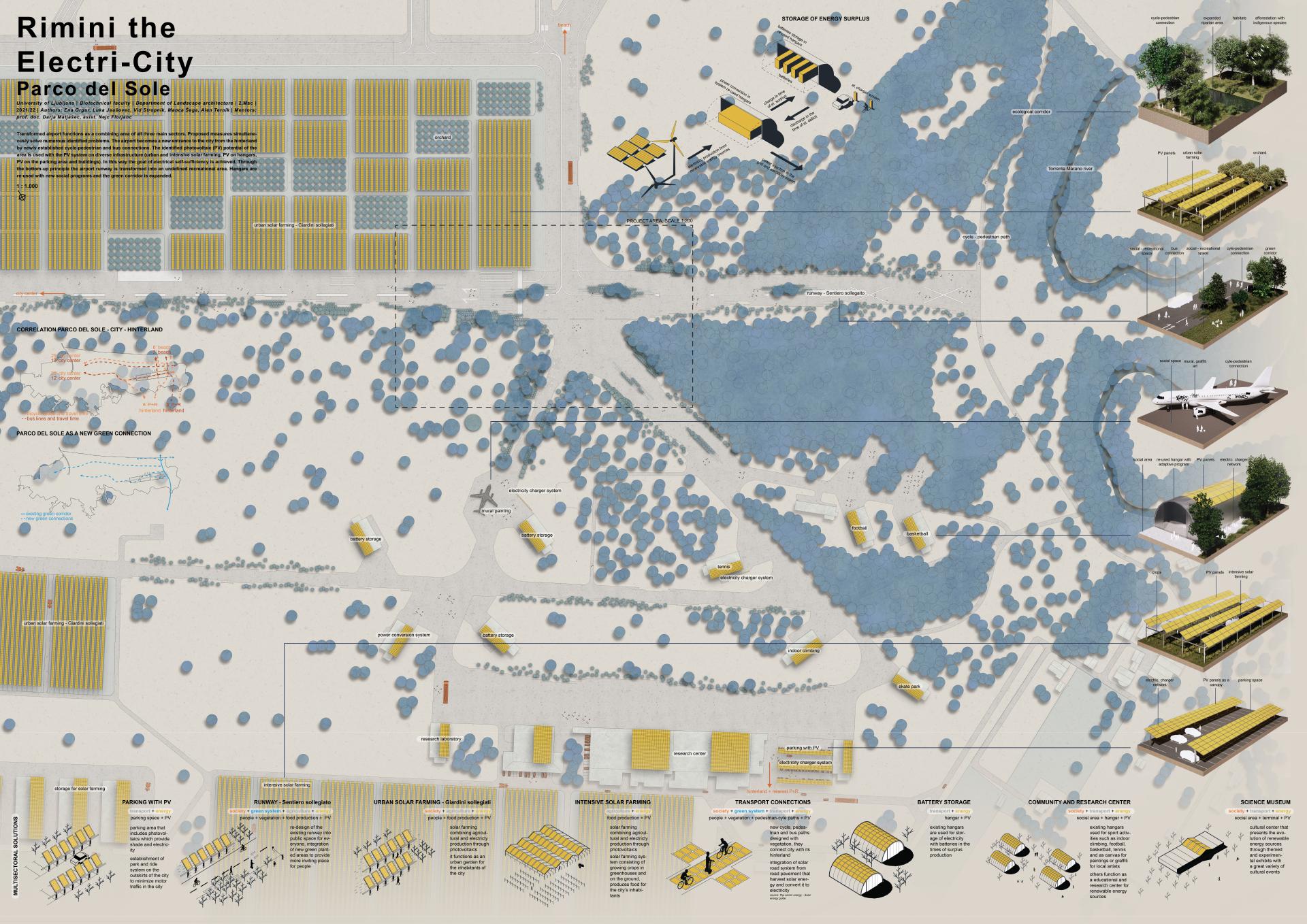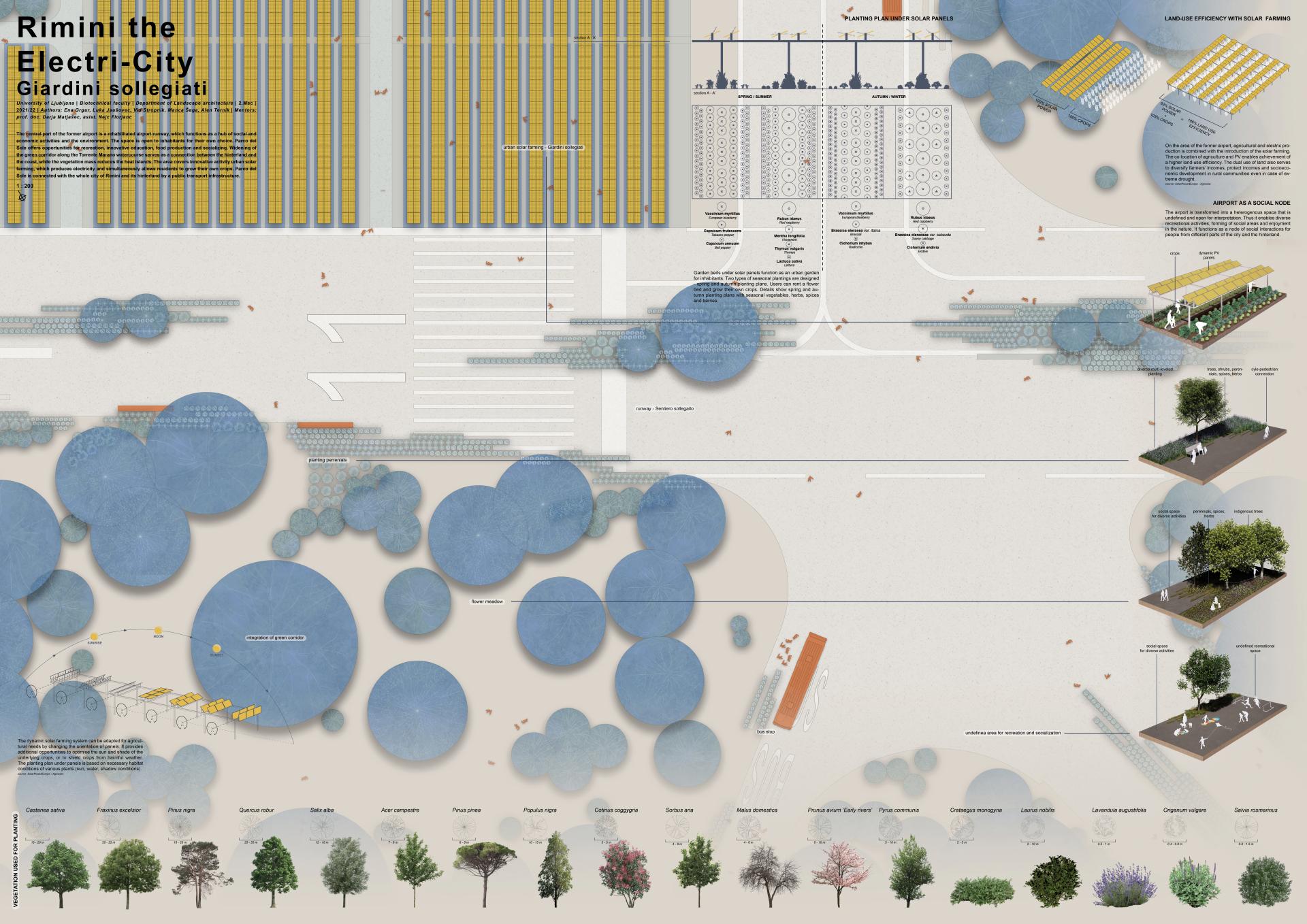Rimini The Electri-City
Basic information
Project Title
Full project title
Category
Project Description
We resolve the identified conflicts in Rimini with multi-sectoral solutions in three main sectors - society, economy and environment, which will transform Rimini into a integrated system. Leading factor in the transformation of Rimini are energy-based measures that achieve the goal of self-sufficiency in renewable energy sources. Rimini’s energetic advancement is also accompanied by the creation of public space through landscape democracy principles, resulting with social and spatial inclusion.
Geographical Scope
Project Region
Urban or rural issues
Physical or other transformations
EU Programme or fund
Which funds
Description of the project
Summary
Rimini is one of the most attractive coastal cities in Italy, visited by millions of tourists every year. This fact is also reflected in its historic development, city characteristics as well as in different conflicts between uses. Recognized conflicts are addressed with multi-sectoral solutions of three main sectors (society, economy and environment), which will transform Rimini into a holistic and connected system. This system is being realized in newly established green corridors, formation of public spaces, transport and social connections coast – city – hinterland. Leading factor in transforming Rimini into the unified system are energy-based measures. They realize the goal of self-sufficiency with renewable energy sources. Photovoltaic system is being implemented on residential buildings, hotels, industrial areas and the airport, while wind farms are being built on the sea. These steps serve as a base for other subsectors solutions and thus energetic transformation of the city is not only energetic but also comprehensive. The airport closing functions as a combining area of all three main sectors and as an opportunity to realize a set of goals by introducing solar farming which connects electrical and agricultural production, expansion of green corridors as well as shaping of the public space through the process of landscape democracy. It also becomes a new entrance to the city and its coast from the hinterland by establishing additional cycle-pedestrian and bus connections. Through the bottom-up principle the airport runway is being transformed into a public area that is open to all inhabitants for interpretation.
Key objectives for sustainability
The idea is based on the creation of an energy system from renewable energy sources with which the city becomes self-sufficient and independent of energy imports. Electricity is produced only from renewable energy sources which are sustainable and have fewer negative impacts on the environment than the use of fossil fuels. As a result, the use of fossil fuels, which have a negative impact on people and the environment through emissions, is reduced. The new model for electricity production by using solar and wind energy follows many sustainable development goals that are affordable and clean energy, economic growth, sustainable cities and communities, responsible consumption and production, climate action and partnerships for the goal. It also follows the principles of the circular economy, as the cessation of fossil fuels reduces environmental pollution, ensures energy circulation through the use of renewable energy sources and enables regeneration of nature by making minimal environmental interventions, as new infrastructure would be installed on existing facilities or degraded areas. A large part of the idea is the involvement of residents in the project, as the use of renewable energy sources ensures affordable energy, improves the quality of the living environment and consequently the quality of life itself. The newly designed energy system is a combination of a sustainable way of obtaining electricity, social inclusion of the inhabitants and improvement of the quality of space and life in the city.
Key objectives for aesthetics and quality
In terms of aesthetics and quality, the rehabilitated central part of the former airport is undoubtedly the most outstanding. Newly transformed space is open to inhabitants for their interpretation and own choice of use. Area doesn't have a specific programme and thus allows free and democratic use of space for all. Parco del Sole offers opportunities for recreation, innovative education, food production and socializing. Widening of the green corridor along the Torrente Marano watercourse serves as a connection between the hinterland and the coast, while the vegetation mass reduces the heat islands and their impact. The area covers innovative activity urban solar farming, which produces electricity and simultaneously allows residents to grow their own crops. Parco del Sole is connected with the whole city of Rimini and its hinterland by a public transport infrastructure. It enables diverse activities from recreation, enjoyment in nature, cultural and touristical visiting to forming of social and community areas etc. Ex-airport area functions as a node of social interactions for people from different parts of the city and the hinterland.
Key objectives for inclusion
Project area is transformed on many levels and sectors or subsectors. Therefore many different spatial problems were recognized, but solutions for those were not met individually. They were multi-layered and complex, yet simple. Numerous innovations did mix with each other and created single solution for great number of problems, or even many solutions for one problem. Hence the energetic transformation of Rimini did not solve only energetic problems and introduce new renewable energy sources, but did also address problem of irrigated farmlands, heat islands, transportation etc. Not to forget that participation process was also used. For example, issues of low share of renewable energy sources, non-irrigated farmlands, energy as well as food dependency and high share of irrational use of space were addressed with solar farming on closed airport with the process of landscape-democracy. Our innovative way of problem solving saves area with multi-layered solutions and adaptive re-use principle.
Airport closing becomes an opportunity to almost double current electrical production of Rimini by introducing solar farming which connects electrical and agricultural production. Additionally, the former airport becomes a new entrance to the city and its coast. Through the concept of landscape democracy, it is transformed into the public space. Thus, it enables an expansion of the green corridor from the hinterland to the city, new transport connections and introduction of new social programs in the existing airport infrastructure. The airport is transformed into a heterogeneous space that is open for interpretation through the bottom-up principle.
On the coast of Rimini, deprivatized beach is transformed into a public space which belongs to everyone – residents and tourists, free of charge. The sand beach is without predefined solutions and is belongs to the community.
Physical or other transformations
Innovative character
By dividing Rimini into three main sectors (society, economy, environment with their subsectors) we can analyse main data and defined main key findings, which allow our plan to embrace goals such as environmental sustainability, increase of landscape quality, quality of experience and social inclusion of residentials and tourists. Main goals are the following: self-sufficiency with electricity from renewable energy sources, close link-up of the city with its coast and hinterland and transformation of the city with the concept of landscape democracy. Goals were achieved through energetic transformation of the city. The transformation is not only energy based, the energy system also serves as a combining link for a sustainable way of obtaining electricity, social inclusion of the inhabitants and improvement of the quality of space and life in the city. Introduction of renewable energy sources (photovoltaic system on residential buildings, hotels, industrial areas, airport and a sea wind farm) will serve as a base for other subsectors solutions. Airport closing becomes an opportunity to almost double current electrical production of Rimini by introducing solar farming which connects electrical and agricultural production. Additionally, the former airport becomes a new entrance to the city and its coast. Through the concept of landscape democracy, it is transformed into the public space. Thus, it enables an expansion of the green corridor from the hinterland to the city, new transport connections and introduction of new social programs in the existing airport infrastructure.




